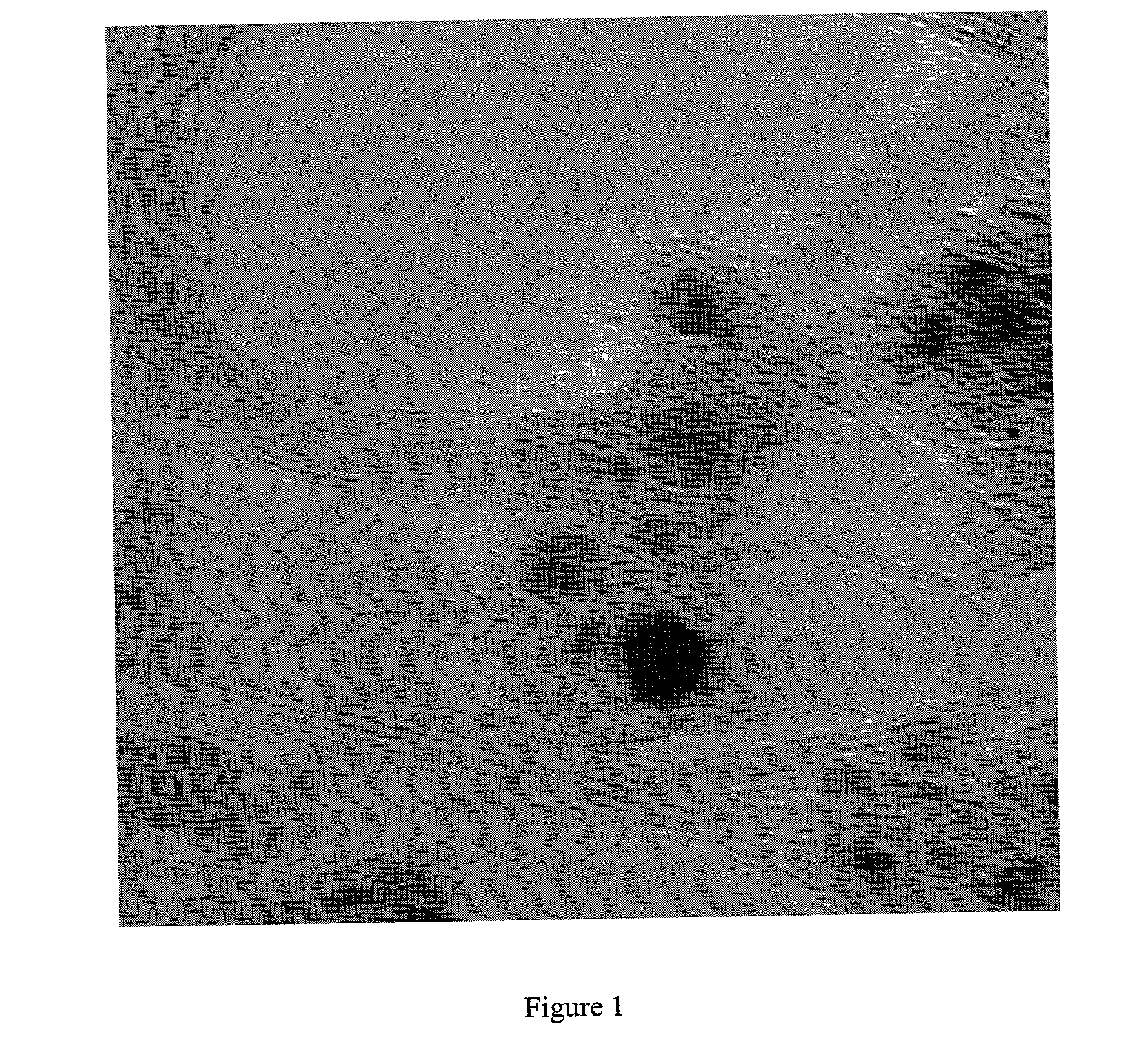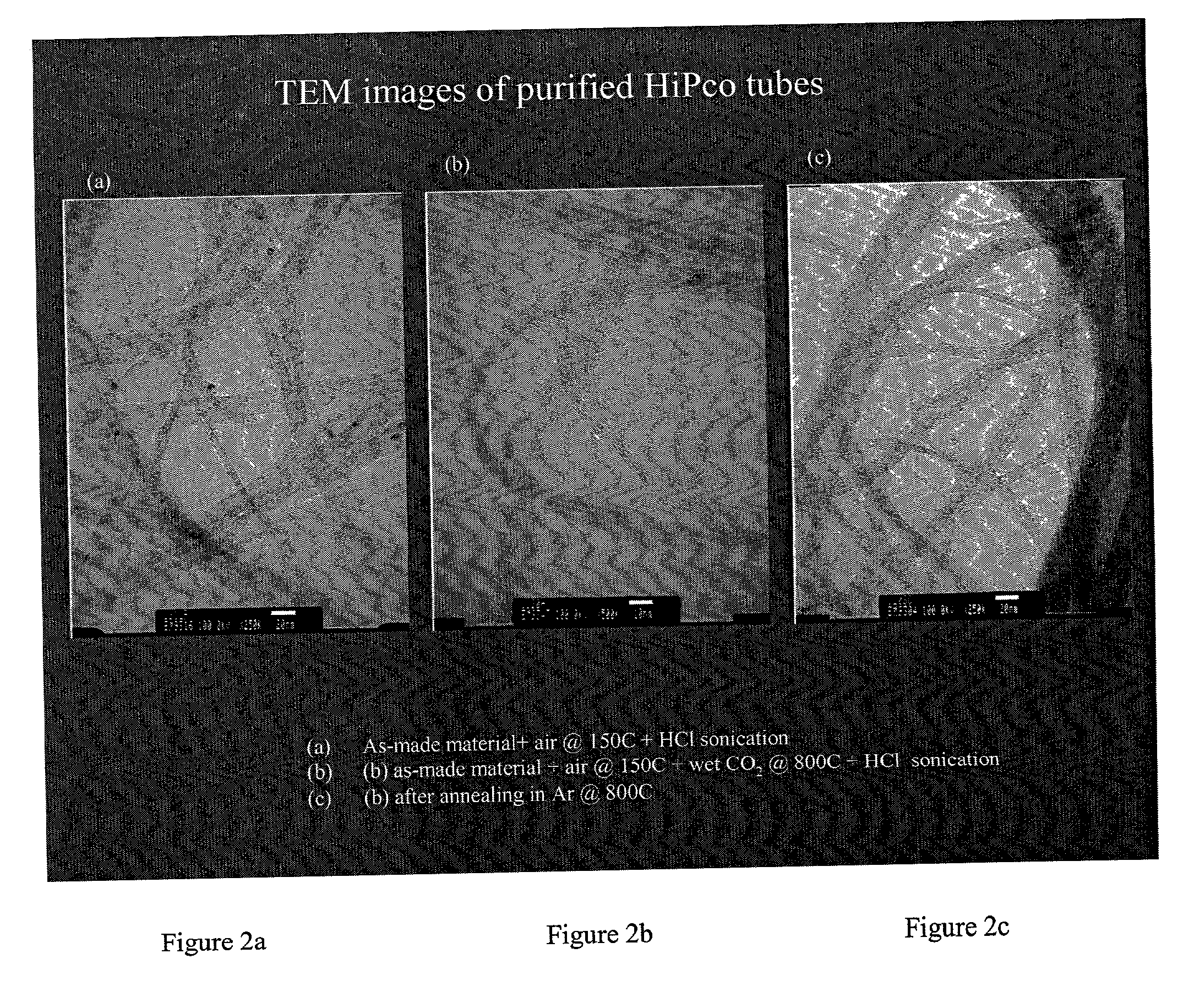Process for purifying single-wall carbon nanotubes and compositions thereof
a carbon nanotube and single-walled technology, applied in single-walled nanotubes, single-walled nanotubes, chemical after-treatment of artificial filaments, etc., can solve the problems of only a low yield of carbon nanotubes, significant variation in structure and size of the population of carbon nanotubes, and heterogeneous product distribution, etc., to achieve the effect of superior nanotube materials
- Summary
- Abstract
- Description
- Claims
- Application Information
AI Technical Summary
Benefits of technology
Problems solved by technology
Method used
Image
Examples
example 1
[0045] In one embodiment of the present invention, single-wall carbon nanotube material as produced by the laser-oven method (Tubes@Rice, Houston, Tex., see Rinzler) was received dispersed in toluene. It was filtered (Whatman #41) and washed with methanol and then water. The single-wall carbon nanotube material was then homogenized with a high-shear mixer (Polyscience X-520) and filtered repeatedly until the filtrate was clear and colorless. The as-produced single-wall carbon nanotube material is then exposed to a low temperature oxidation at about 200.degree. C. at a pressure of about one atmosphere in a gas mixture comprising approximately 80% inert gas, such as argon, approximately 20% oxygen, and also contains a small amount of about 1% water vapor. Moist air also functions in this process. Oxidation of the metal occurs as the oxygen and water vapor breaches the carbon over-coating of the catalyst particle, and slowly converts the iron catalyst particle to a particle that contai...
example 2
[0049] Single-wall carbon nanotube material as-produced by the laser-oven method (Tubes@Rice, Houston, Tex., see Rinzler) was received dispersed in toluene. It was filtered (Whatman #41) and washed with methanol and then water. The single-wall carbon nanotubes were then homogenized with a high-shear mixer (Polyscience X-520) and re-filtered repeatedly until the filtrate was clear and colorless. The as-produced single-wall carbon nanotube material is then exposed to a low temperature oxidation step (200.degree. C.) at a pressure of one atmosphere in a gas mixture comprising approximately 80% inert gas, such as argon, approximately 20% oxygen, and a small amount, of approximately 1%, water vapor. Moist air also functions in this process. Oxidation of the metal occurs as the oxygen and water vapor breaches the carbon over-coating of the catalyst particle, and slowly converts the iron catalyst particle to a particle that contains iron oxide and / or iron hydroxide. As the particle is thus...
example 3
[0053] In this example, single-wall carbon nanotube material made by the process described in WO 00 / 26138 (see also Nikolaev, et al., Chemical Physics Letters 1999, 313, 91) is purified by gas-phase oxidation, acid extraction, and high-temperature annealing.
[0054] The dominant impurity in an unpurified sample of single-wall carbon nanotube material made by this process is the metal catalyst, comprising primarily iron, which is encased in thin carbon shells and distributed throughout the sample as about 3-5 nm particles. The laser-oven, arc, and supported catalyst methods of producing single-wall carbon nanotubes use different catalysts, but all catalysts are transition metals amenable to the same procedure described below.
[0055] In this example, as-produced single-wall carbon nanotube material is first compressed by adding single-wall carbon nanotubes to a filter holder while pulling a vacuum beneath the filter. The single-wall carbon nanotubes are physically compressed onto the fil...
PUM
| Property | Measurement | Unit |
|---|---|---|
| temperature | aaaaa | aaaaa |
| temperature | aaaaa | aaaaa |
| temperature | aaaaa | aaaaa |
Abstract
Description
Claims
Application Information
 Login to View More
Login to View More - R&D
- Intellectual Property
- Life Sciences
- Materials
- Tech Scout
- Unparalleled Data Quality
- Higher Quality Content
- 60% Fewer Hallucinations
Browse by: Latest US Patents, China's latest patents, Technical Efficacy Thesaurus, Application Domain, Technology Topic, Popular Technical Reports.
© 2025 PatSnap. All rights reserved.Legal|Privacy policy|Modern Slavery Act Transparency Statement|Sitemap|About US| Contact US: help@patsnap.com


